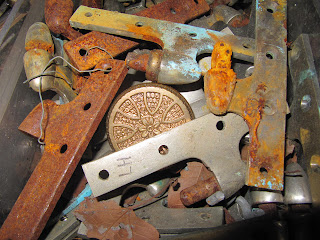The Liberation of the Doorknob

Recently, I encountered Walter Benjamin's essay on technology and representation. Benjamin is trying to reconcile ideas of mass representation (as well as mass production) with notions about 'aura.' For Benjamin, aura is something that is present at the moment of creation within a piece of art and is intrinsically and inherently tied to it for the rest of its life. The issue that he sees in an age of mass reproduction and representation is that our mechanized and instantaneous media for remediation upon a piece of art subtracts from its value. Thus he sees that modern modes of representation play a dichotomous role within the work of art: our interaction with the newly remediated representation of art stands distinct from the aura of the original work of art.
I start with this as a departure point from which I think architectural salvage is connected. As I was sorting through bins of hardware the other day, I found at the bottom of a rusted bucket of ball-tip hinges a singular idiosyncrasy towards the bottom: an Eastlake doorknob. The patina-coated brass immediately jumped out at me as my eyes traced the organic aesthetics of the patterning, following the flower design and asymmetrical engravings of the doorknob. As I held it, Benjamin's notion of aura slipped into my mind. The doorknob was a piece of art; its cast decoration standing apart from the mere utility of opening a door. But while this was true, at the same time, the doorknob was a testimony to the machine that was the focal point of the Victorian era. Intricate patterning and ordering was the status quo of the day. If there were to exist Benjamin's notion of an authentic aura anywhere within the doorknob, it was not in the doorknob itself (the tangible representation of the art that I was holding in my hand), but rather it existed within some sort of original mold that had long ago fallen victim of rust, decay, neglect, and other incidental qualities that attach themselves to the incessant march of time. But unlike a print of say a painting, in which we see through the layers of remediation and can more accessibly discern the supposed original aura, the recontextualization of the doorknob within in its juxtaposition of, not only being in the bottom of a rusted bucket of hinges, but also of being in a salvage yard itself, changes the value of the aura of the doorknob all together.
Architectural salvage redefines the value of the items that we collect. Removing the objects from their uniform utility allows for a level of removal that creates a redistribution of aura within the object (I posit the word 'uniform' here in the sense that houses traditionally keep a uniform aesthetic continuity, i.e. a house will usually have all single panel doors, or a kitchen will have cabinet pulls/knobs that are all of the same design). Walking through the salvage yard we are able to transverse through layers and layers of thought, history, design, etc... in the blinking of an eye. We can move from the heavy, geometric beats of Art Deco to the fluidity of Art Nouveau just by following the lines in a light fixture. Instead of their existing a linearity in the infusing of aura (that is to say, the aura exists in the original casting of say a doorplate and is then redistributed through each secondary casting and remains in the object throughout its lifetime within the house), the objects here instead exist in a continuum of aura. Each object in its idiosyncratic existence at the salvage yard becomes complete in and of itself.
Architectural salvage yards allow for this new ascriptive existence: a removal from utility and conformity leads into a new ascription of aura within the individual object. Instead of trying to negotiate with the layers of distance we stand from the original, we encounter the objects as discrete and complete entities unto themselves. With this in mind, we can see how architectural salvage allows for an aesthetic liberation: there isn’t the hierarchal obligations that we attach to utility (by this, I again, return to the aesthetic uniform continuity that I suggested before), but rather we see each object as being an open canvas upon which we can inscribe new meanings and new contexts that will allow for a new aura to be created. The four-panel door from a Victorian is reshaped into a table, the doorknob is turned into a coat hook, the multi-light window becomes a mirror, ad infinitum. Architectural salvage is a tangible embodiment of what Ezra Pound said of literature, that we must always, “Make it new.”
By Henry Lacey Ivry



Comments
Post a Comment